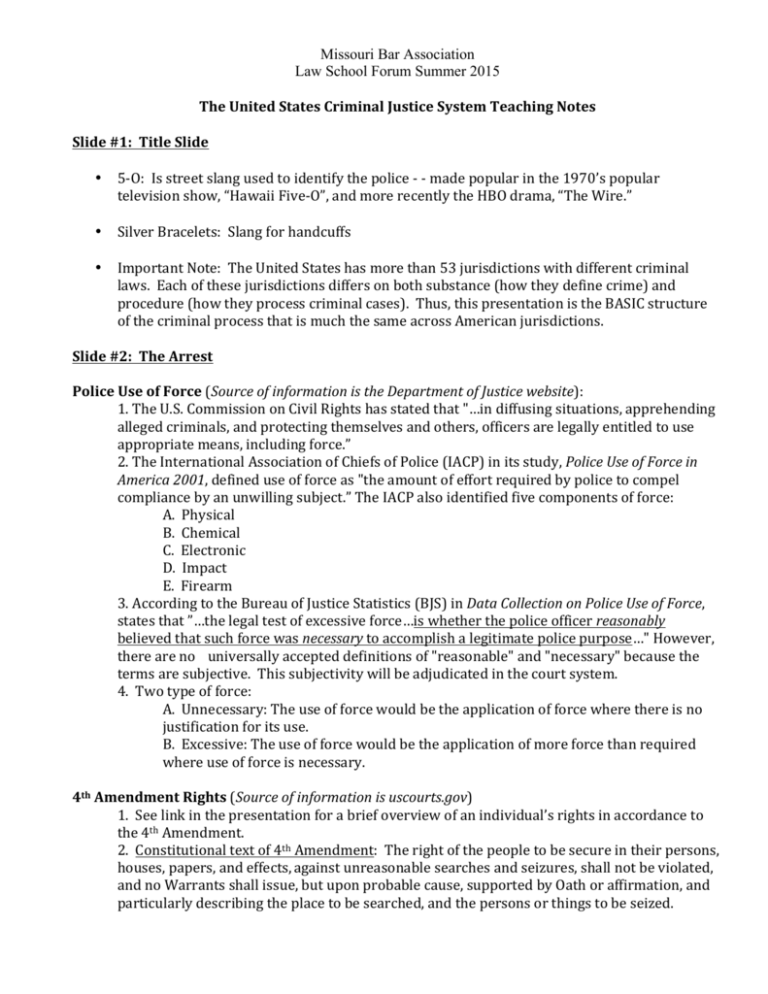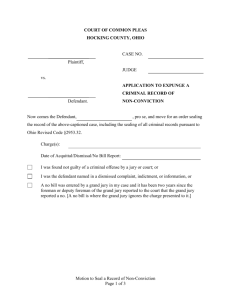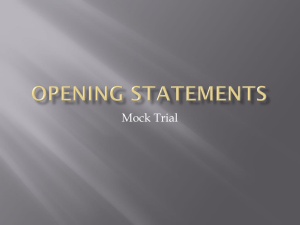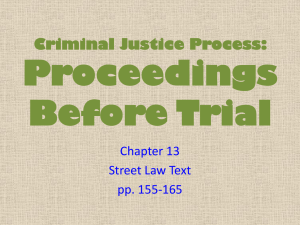The United States Criminal Justice System Teaching Notes
advertisement

Missouri Bar Association Law School Forum Summer 2015 The United States Criminal Justice System Teaching Notes Slide #1: Title Slide • 5-­‐O: Is street slang used to identify the police -­‐ -­‐ made popular in the 1970’s popular television show, “Hawaii Five-­‐O”, and more recently the HBO drama, “The Wire.” • Silver Bracelets: Slang for handcuffs • Important Note: The United States has more than 53 jurisdictions with different criminal laws. Each of these jurisdictions differs on both substance (how they define crime) and procedure (how they process criminal cases). Thus, this presentation is the BASIC structure of the criminal process that is much the same across American jurisdictions. Slide #2: The Arrest Police Use of Force (Source of information is the Department of Justice website): 1. The U.S. Commission on Civil Rights has stated that "…in diffusing situations, apprehending alleged criminals, and protecting themselves and others, officers are legally entitled to use appropriate means, including force.” 2. The International Association of Chiefs of Police (IACP) in its study, Police Use of Force in America 2001, defined use of force as "the amount of effort required by police to compel compliance by an unwilling subject.” The IACP also identified five components of force: A. Physical B. Chemical C. Electronic D. Impact E. Firearm 3. According to the Bureau of Justice Statistics (BJS) in Data Collection on Police Use of Force, states that ”…the legal test of excessive force…is whether the police officer reasonably believed that such force was necessary to accomplish a legitimate police purpose…" However, there are no universally accepted definitions of "reasonable" and "necessary" because the terms are subjective. This subjectivity will be adjudicated in the court system. 4. Two type of force: A. Unnecessary: The use of force would be the application of force where there is no justification for its use. B. Excessive: The use of force would be the application of more force than required where use of force is necessary. 4th Amendment Rights (Source of information is uscourts.gov) 1. See link in the presentation for a brief overview of an individual’s rights in accordance to the 4th Amendment. 2. Constitutional text of 4th Amendment: The right of the people to be secure in their persons, houses, papers, and effects, against unreasonable searches and seizures, shall not be violated, and no Warrants shall issue, but upon probable cause, supported by Oath or affirmation, and particularly describing the place to be searched, and the persons or things to be seized. Missouri Bar Association Law School Forum Summer 2015 Probable Cause: 1. An excellent 45 second Youtube video summarizing the concept of probable cause is linked in the presentation under probable cause. 2. Definition: Probable cause is a requirement found in the Fourth Amendment that must usually be met before police make an arrest, conduct a search, or receive a warrant. Courts usually find probable cause when there is a reasonable basis for believing that a crime may have been committed (for an arrest) or when evidence of the crime is present in the place to be searched (for a search). Under exigent circumstances, probable cause can also justify a warrantless search or seizure. Persons arrested without a warrant are required to be brought before a competent authority shortly after the arrest for a prompt judicial determination of probable cause. (Source: Cornell University Law School website) Miranda Warning: 1. Every US jurisdiction can have its own regulation regarding a Miranda warning, but a typical warning includes. A. You have the right to remain silent B. Anything you say can be used in court C. You have the right to an attorney before or while speaking to the police D. If an attorney cannot be afforded, one will be appointed to you E. You can stop answering police questions at any time F. A statement from you declaring a willingness to answer police question without an attorney present. 2. Source of the Miranda Warning: Miranda v. Arizona, 384 U.S. 436 (1966). An embedded link from the Oyez Project is in the presentation. This link provides an excellent brief description of this landmark Supreme Court case. Note: Bill Gates is pictured in the slide. He was arrested in Albuquerque, NM on 12/13/1977 for driving without a license and not stopping at a stop sign. Slide #3: Bail or Detention Initial Appearance: 1. Once a person is arrest by law enforcement they must be taken before a judge without unnecessary delay. Needs to be within 48 to 72 of the arrest. 2. During this appearance the judge will: A. Inform the accused of the charges against him/her. B. Decide if enough initial probable cause exist to detain the accused person. C. Assign/Recognize defense counsel D. Determine if the accused is eligible for bail. 3. Is also referred to as an initial arraignment. 4. A 2:02 minute Youtube link to an initial appearance of Justin Bieber is linked to “Initial Appearance” The Basics of Bail: 1. Bail is money, a pledge of property, or a promise to the court (recognizance) in exchange for an accused to be at liberty (free) so long as he/he returns to court for all necessary hearing regarding an arrest. Once the matter is completely adjudicated the bail will be returned to the Missouri Bar Association Law School Forum Summer 2015 accused. It does not matter of the arrested is eventually found guilty or innocent of the accused crime. 2. If the arrested misses a court date, the bail may be forfeited to the court and a warrant will be issued for the accused arrest. AKA bail jumping, which is crime in itself. 3. The amount of bail is set at an amount large enough to convince the accused to return to court. A number of factors influence to bail account: A. The jurisdiction of the court B. Seriousness of the alleged crime C. The accused’s criminal record D. The likelihood the accused with flee the area to avoid trial E. The financial resources of the accused Detention: 1. Based on the factors above a judge can deny bail to the accused, forcing them to stay in jail until the conclusion of his/her trial. 2. US v. Salerno: Detainment of person without the opportunity for bail is constitutional because the government's interest in protecting the community outweighs individual liberty, pre-­‐trial detention can be "a potential solution to a pressing societal problem.” The Oyez Project is linked to this case in the presentation. Bail Bondsman: 1. A link to an excellent 1 minute 24 second YouTube video describing how the process of using a bail bondman works is embedded under “Bail Bondman.” 8th Amendment: 1. The court cannot set “excessive bail” forcing the accused to stay in jail until trial. 2. Constitutional text of 8th Amendment: Excessive bail shall not be required, nor excessive fines imposed, nor cruel and unusual punishment inflicted. 3. In Stack v. Boyle the court found "that a defendant's bail cannot be set higher than an amount that is reasonably likely to ensure the defendant's presence at the trial.” Thus, two people of different financial means that commit the exact same crime can have two different bail amounts. Slide #4: Charges Filed Note: If you click on the image you will be taken to a cnn.com website showing the criminal complaint against Dzhokhar Tsarnaev – The Boston Marathon Bomber. Police Present Evidence to Prosecutor: 1. For a case to proceed the county prosecutor/district attorney should be able to answer the following three questions in the affirmative: A. Is there sufficient evidence of ALL elements of the crime? B. Am I (the prosecutor) convinced that the defendant is guilty? C. Does the evidence support the conclusion that the available evidence will lead to a conviction by the beyond a reasonable doubt standard? Missouri Bar Association Law School Forum Summer 2015 Prosecutors Options: 1. Not pursue the case: A. If any of the above questions are answer in the negative, then the prosecutor has the obligation to not file charges with the court. B. The prosecutor has taken a legal oath to faithfully execute his/her duties and to uphold the constitution of the state where he works and the Constitution of the United States of America. The obligation to do so and seek justice is frequently included and that gives the prosecutor the duty to represent the interests of all the people, which includes those accused of crimes as well as the victims. 2. Present Evidence to a Grand Jury: A. This is what Bob McCullough, the St. Louis county prosecutor, did in the case involving the death of Michael Brown in Ferguson, Missouri in the Summer of 2014. B. When a felony crime has occurred, a prosecutor can leave it to a grand jury to decide if a charge should be filed. C. Grand juries are selected from the same pool of citizens as a trial jury (petit jury). Unlike petit juries, a grand jury will typically sit for anywhere between six months to eighteen months before they are dismissed by the court. D. A grand jury’s only job is to determine if enough evidence exist to warrant a criminal trial. E. No judge or defense of the accused is present in a grand jury proceeding F. Grand juries meet in secret, can ask question of witnesses, and have the power of subpoena via the court. Grand jury proceedings are secret because: i. It encourages witnesses to speak freely and without fear of retaliation ii. It protects the potential defendant’s reputation in case the jury does not decide to deliver a true bill. G. Grand juries can ask the prosecutor questions about the law, and do not have to adhere to the strict rules of evidence used in a trial court. H. Grand juries determination, unless petit juries in a criminal case, do NOT have to be unanimous to indict. Typically only 2/3 or 3/4 needed to deliver a true bill depending on the jurisdiction. I. During grand jury proceedings the prosecutor presents the evidence of the case typically in one of two ways: i. Present just enough evidence to obtain probable cause and gain a true bill (a decision to indict) ii. Present all the evidence and allow the grand jury to determine if enough evidence exist to deliver a true bill or not bill. J. Even if the grand jury delivers a no bill, the prosecutor can return to the same grand jury with more evidence, present the same evidence to a second grand jury, or choose to bypass the grand jury and file a criminal complaint. K. A 25:43 minute YouTube link via the PBS News Hour is embedded under “Ferguson” to the grand jury decision not to indict officer Darren Wilson in the shooing death of Michael Brown. 3. File a Complaint: A. Also is called a preliminary hearing, evidentiary hearing, or probable cause hearing. Missouri Bar Association Law School Forum Summer 2015 B. Purpose is for the judge to make a ruling that the evidence presented to the court provides probable cause to believe that the defendant committed the crime. C. Unlike grand jury proceedings, in a preliminary hearing the defendant can be represented by counsel. D. The use of preliminary hearings vary based on jurisdictions: i. Some jurisdictions hold hearings in all criminal cases ii. Some jurisdiction hold hearing only at the request of the defense iii. Some jurisdiction hold hearings only in felony cases. E. Per federal law, if a person is is accused of a felony crime in a federal court, pursuant to the 5th Amendment to the US Constitution, (s)he has a right to a grand jury indictment. F. The two major questions to answer in a preliminary hearing: i. Did the alleged crime occur within the court;s jurisdiction? ii. Is there probable cause to believe that the defendant committed the crime? E. If both the question directly above are answered in the affirmative the defendant is “bound over” for a trial. Slide #5: Arraignment During arraignment the judge will: 1. Inform the accused of the charges against him/her. Called the indictment. 2. Allow the defendant to enter a plea A. Not Guilty: Judge will schedule a date for future proceeding related to the case B. Guilty: Judge will schedule an evidentiary hearing to place the fact of the case on the record. C. No Contest (nolo contendere): The defendant neither admits nor disputes a charge, thus the judge will treat a plea of no contest as such an admission and proceed to find the defendant guilty as charged. Note: The picture in this slide is of Ariel Castro’s arraignment. His was found guilty of the kidnapping of three girls in the Cleveland area over a period of ten years. His 2:30 minute long arraignment on YouTube is embedding under “Take the defendant’s plea.” Slide #6: Criminal Discovery What is Discovery: 1. The purpose of discovery is to exchange information and facts about the case. 2. Criminal Discovery takes place before trial with two major goals: A. Provide the defendant the best possible chance to have a fair trial that is in align with his/her constitutional right. B. By the prosecutor providing all the evidence against the defendant, the defendant may be more likely to agree to a plea agreement. Favors Defendant: 1. The defendant has NO obligation to voluntarily provide evidence of information which may incriminated the defendant. The defendant’s 5th Amendment protection against self-­‐ incrimination applies to the discovery process. Missouri Bar Association Law School Forum Summer 2015 2. What must be disclosed by the government? A. Oral and written statements made by the defendant to police officers B. Tape-­‐recorded statements of the defendant C. Testimony by the defendant at a grand jury D. Defendant’s criminal record E. Books, papers, documents and photographs F. Information from a physical or mental examination E. Information from a scientific test or experiment F. Names and qualifications of experts and a summary of their testimony 3. Per Brady v. Maryland (1963) & Giglio v. United States (1972 if the government has exculpatory evidence (evidence that tends to excuse, justify, or absolve the alleged fault or guilt of a defendant) the government must share that information with the defendant. Different than Civil: A link is imbedded in “Different than Civil” to the American Bar Association’s comparison between the criminal and civil discovery process. Slide #7 – Plea Deal (Bargain) Is a Negotiation: 1. The prosecutor and defendant will attempt to form an agreement with terms favorable to both parties, for example: A. Prosecutor will agree to reduce the charge and/or sentencing of the defendant if the defendant agrees to plead guilty to the reduced charge and/or cooperate in further investigation of other individuals. 2. The vast majority criminal charges never make it to trial, they are “plead out” between the prosecutor and defendant. 3. Criticism of plea deals: A. Some believe plea deals allow defendants to get off too easy. B. Some argue the plea bargain system is coercive and undermines important constitutional rights. Why Plea: 1. A YouTube video of Justin Bieber’s lawyers making a Plea deal is embedded under “Why Plea”. 2. Often times, a plea deal will be to the ultimate benefit of a defendant: A. Time: Criminal trials, depending on the jurisdiction’s backlog of cases, can take a significant amount of time to reach a final adjudication. B. Harsher Punishment: Defendant can avoid the possibilities of receiving harsher punishment from the jury or judge. C. Publicity: Criminal trials are open to the public, thus a defendant can avoid public embarrassment by striking a plea deal. D. Risk/Reward Analysis: A jury can be very unpredictable in its decision. A plea deal can eliminate this risk of a more serve punishment, but also eliminate the reward of a lighter punishment. 3. Plea deals also can benefit the prosecutor by allowing him/her to conserve limited human resource. Plea deals can also reduces the burden on the court system in general, making it faster and more efficient. Missouri Bar Association Law School Forum Summer 2015 Judge Must Agree To: 1. Important to note: When a defendant agrees to a plea bargain, the defendant must go before the judge and state (s)he is voluntarily waving three rights protected under the Fifth and Sixth Amendments: A. Right to a jury trial B. Right against self-­‐incrimination C. Right to confront hostile witnesses Brady v. US (1970): Held plea bargains are constitutional McCarty v. US (1969): Held a defendant’s guilty plea MUST be voluntary and the defendant may only plead guilty if they know the consequences of doing so Slide #8: Criminal Trial • These are the ten major steps in a criminal trial – this slide is an entire presentation within itself. Slide #9: Sentencing Types of Sentencing: 1. Probation (From a federal perspective): A. A way to monitor the activities and behaviors of people released to the community buy the federal courts or paroling authorities B. An opportunity to help offenders reintegrate into the community following a period of incarceration. C. Provides a punishment that is less severe than imprisonment, but still holds people accountable for breaking the law. D. An alternative to jail or prison that cost less than incarceration and gives people charged with or convicted of federal crimes the opportunity to live with their families, hold jobs, and be productive members of society. E. Example of probationary conditions: i. Prohibited possession of guns or weapons ii. Prohibited contact with victims or witnesses iii. Restricted association with certain people iv. Restricted travel v. Imposed curfew vi. Electronic monitoring vii. Substance abuse screening and/or treatment viii. Community Service 2. Fine & Restitution: The defendant can be order to pay: A. Fines: Intended to have a deterrent and punitive effect. B. Restitution: Compensation, typically monetary, to the victim of the defendant for injury or loss 3. Suspended Sentence: A suspended sentence is a legal term for a judge's delaying imposition of the defendant's sentence after they have been found guilty, in order to allow the Missouri Bar Association Law School Forum Summer 2015 defendant to perform a period or probation. Often, if the probation is successfully served the original sentence can be waived by the judge. 4. Incarceration: A. Jail: Is short term incarceration -­‐ -­‐ typically one year or less B. Prison: Is long-­‐term incarceration – typically one year or longer Federal Sentencing Guidelines: 1. In 1987 the Federal government, established non-­‐binding uniform sentencing policies for defendants convicted of crimes in the US federal court system. 2. The guidelines are not mandatory, but judges must consider them when determining a criminal defendant’s sentence. 3. When a judge departs from the guidelines, he/she must explain what factors warranted the increased or decreased sentencing. Note: I have embedded under “Federal Sentencing Guidelines” a website that can be used to estimate the type a federal sentence a person would expect to receive based on a number of different variables. In this lesson is also a chart that details the federal sentencing process. Slide #10: Appeal Defendant Appeal Rights: 1. When a defendant appeals to a higher court, the higher court is not evaluating the factual determination of the lower court (the lower court is the finder of fact, rarely will a court of appeals over rule the lower court based on the facts of the case.) 2. A court of appeals is evaluating if a legal error occurred during the lower court proceedings. Examples include: A. Error in rule on the admittance of evidence B. Improper jury instructions C. Error in allowing certain witnesses to testify 3. The court of appeals will evaluate the record of the lower court and determine: A. The error was harmless, thus the lower court’s verdict stands. B. The error is reversible, thus the appeal court can: i. Have a new trial held ii. Can modify or correct the lower court’s verdict iii. Can remand the case back to the lower court for further evaluation with new guidance from the court of appeals. 4. A defendant has a due process right to appeal a verdict and/or sentencing determination. 5. A defendant has one guaranteed opportunity to appeal a trial verdict. The Supreme Court of the United States is obligated to evaluate the merits of a defendant’s appeal, but it is not obligated to hear the defendant’s appeal. Prosecutor Appeal: Only in a very extreme/rare case can a prosecutor appeal an acquittal of a defendant. The prosecutor only gets “one bite of the apple.”









